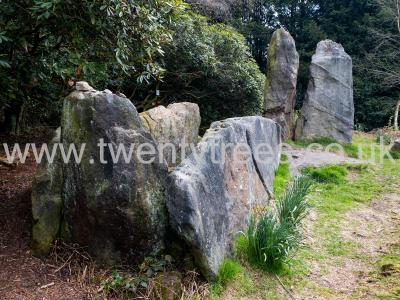Europe, British Isles, North-Central England, Staffordshire, Biddulph
Biddulph, Staffordshire is in Staffordshire.
Europe, British Isles, North-Central England, Staffordshire, Biddulph, St Lawrence's Church
Around 850 the Danes aka Vikings are believed to have destroyed a Saxon church on the site of St Lawrence's Church, Biddulph. This was later replaced by a Saxon church, probably of stone, since the arch to the belfry is of Saxon type. On the wall of the West end of the present church can be seen the names of past incumbents of St Lawrence, dating back to 1274 but records show that there were others dating back to 1190. There is a gap between 1377 and 1535, when the Parish was administered by the Abbots of Hulton Abbey, and this may have been due to the possibility that many clergy perished during the Black Death. The arrangement with Hulton Abbey continued until the Abbey's closure during the Reformation under Henry VIII. During the Civil War the church was badly damaged by Cromwell's troops and the stained glass windows smashed but the vicar at that time collected the fragments and preserved them. They were later fitted into the East window where they can still be seen.
On 05 Apr 1719 Thomas Gresley 4th Baronet (age 20) and Dorothy Bowyer were married at St Lawrence's Church, Biddulph.
Europe, British Isles, North-Central England, Staffordshire, Biddulph, The Bride Stones [Map]
The Bride Stones, Cheshire is also in Peak District Neolithic Burials.
The Bride Stones, Cheshire [Map] is Neolithic Chambered Cairn constructed in the Neolithic period between 3500–2400 BC. It was described in 1764 as being 120 yards (110 m) long and 12 yards (11 m) wide, containing three separate compartments, of which only one remains today.
















Mona Antiqua Restauranta 319 Of the Bride Stones. Of the Bride Stones [Map].
To these Letters it may not be improper to add the following, which contains the description of an ancient Druidical monument, called the Bride Stones; and was communicated to us by the Rev. Mr. Thomas Malbon, rector of Congleton in Cheshire. It is not only curious in itself; but is nearly allied to the subject of this book, and serves to confirm some remarks which our author has made in the foregoing Essays.
The Bride Stones are in the parish of Biddulph in the county of Stafford; and sland on a rising ground in the break or opening between the Cloud and Woof-Lowe — which are two of the chain of hills that run through Staffordshire, Cheshire, Derbyshire, and Yorkshire, into Scotland.
A A, &c. * are fix upright, free stones, from three to fix feet broad, of various heights and shapes, fixed about six feet from each other in a semicircular form, and two within, where the earth is very black, mixed with ashes and oak-charcoal. It is apprehended the circle was originally complete, and twenty-seven feet in diameter; for there is the appearance of holes where stones have been, and also of two single stones, one standing East of the circle, at about five or six yards distance, and the other at the same disftance from that.
B B are rough, square, tapering stones, four feet three inches broad, and two feet thick. One on the North side is broken off, as is part of the other.
C C is the pavement of a kind of artificial cave. It is composed of broken pieces of stones about two inches and a half thick, and laid on pounded white stones about six inches deep; two inches of the upper part of which are singed with black, supposed from the ashes falling through the pavement, which was covered with them and oak-charcoal, about two inches thick. Several bits of bones were also found, but s small that it could not be discovered whether they were human or not.
The sides of this cave, if I may so call it, were originally composed of two unhewn free stones, about eighteen feet in length, fix in height, and fourteen inches thick at a medium. Each of them is now broken into two.
D is a partition slone slanding across the place, about five feet and a half high, and six inches thick. A circular hole is Cut through this stone, about nineteen inches and a half in diameter.
The whole was covered with long, unhewn, large, flat free ftones, since taken away. The height of the cave from the pavement to the covering is five feet and ten inches.
The entrance was filled up with free stones and earth, supposed to be dust blown by the wind from year to year in dry weather.
There remains another place of the same construction, but smaller, and without any inward partition, about fifty-five yards distant from this. It is two yards and a half long, two feet and a half broad, and three feet two inches high. There is also a part of another.
There was a large heap of stones that covered the whole, an hundred and twenty yards long, and twelve yards broad. These stones have been taken away from time to time by masons and other people, for various purposes. And in the year 1764, several hundred loads were carried away for making a turnpike-road about fixty yards from this place, which laid it open for examination.
This ancient sacred place was probably covered, says Mr. Malbon. with this great heap of stones to conceal and preserve it it the time the Druids were on the decline, But we rather think, as these Carnedde or heaps of stones were a general appurtenance of Druidical worship, that this, though of a different figure from these commonly known made a real part of the original structure.
